Abstract
Superhydrophobic coatings on aluminum play a crucial role in enhancing corrosion resistance in harsh marine and chloride-rich environments. This study introduces a scalable fabrication method for superhydrophobic aluminum surfaces exhibiting outstanding corrosion resistance. The process involves a two-step technique combining chemical etching with atmospheric pressure chemical vapor deposition (AP-CVD) of perfluorooctyltriethoxysilane (PFOTES). Hierarchical micro- and nanostructures were created by HCl etching, followed by conformal PFOTES functionalization to impart low surface energy. The fabricated surfaces demonstrated water contact angles reaching as high as 175°, coupled with very-low-contact-angle hysteresis, indicative of the Cassie–Baxter wetting state. Electrochemical analyses in saline environments demonstrated a substantial increase in charge transfer resistance and a reduction in corrosion rates by more than an order of magnitude compared to uncoated aluminum, with inhibition efficiencies exceeding 98%. Extended salt spray testing corroborated the durability and efficacy of the dual-modified surfaces. This facile and cost-effective method offers promising prospects for multifunctional aluminum components in marine, infrastructure, and aerospace applications where long-term protection against aggressive environments is required.
1. Introduction
Aluminum is widely adopted in aerospace, maritime, automotive, and civil engineering sectors due to its favorable mechanical and lightweight properties. However, its broader application is fundamentally restricted by vulnerability to corrosion especially pitting and intergranular forms that prevail in chloride-rich atmospheres often undermining structural stability and safety [,,]. This longstanding challenge has prompted significant research interest in advanced surface modification technologies designed to deliver not just corrosion inhibition, but also additional benefits such as resistance to surface fouling and self-cleaning. A highly effective strategy involves creating superhydrophobic surfaces with water contact angles typically above 150° and low-contact-angle hysteresis, enabling water droplets to roll off easily. This property helps to minimize both corrosion and the buildup of biological contaminants [,,]. These behaviors are underpinned by classical and contemporary wetting models that emphasize the synergy between hierarchical roughness and chemical treatments that minimize interfacial free energy []. Recent advances have established that imparting tailored micro- and nanoscale topographies to aluminum—through means such as chemical etching—followed by surface functionalization with hydrophobic agents, can dramatically augment both water repellency and resistance to corrosive media []. Acid-mediated etching protocols using reagents like HCl or HF, efficiently generate densely textured oxide features that serve as ideal scaffolds for subsequent modification with fluorinated silanes or polymers, producing surface states with contact angles exceeding 160° and marked improvements in anti-corrosive performance [,,]. Furthermore, anodization routes have been leveraged to produce tunable, multiscale aluminum roughness; when followed by deposition of hydrophobic coatings, these methods not only enhance protection but also impart notable wear resistance. Chemical vapor deposition of organosilanes and fluoroploymers has likewise enabled the creation of conformal hydrophobic layers on pre-texturized aluminum, yielding robust superhydrophobic films that withstand extended environmental and mechanical exposures [].
A recent surge in the development of robust and environmentally considerate superhydrophobic coatings for aluminum and its alloys has garnered significant attention. Such coatings have emerged as multifunctional barriers, boasting not only corrosion protection but also attributes like anti-icing and mechanical durability []. Simplified processing strategies—such as boiling water treatment paired with fatty acid grafting, or integrated spray-based etching and chemical modification—have made possible scalable and cost-effective routes to water-repellent aluminum surfaces offering added self-cleaning and thermal management benefits [,]. For instance, A. Khaskhoussi et al. demonstrated that etching AA6082 alloy surfaces in HF/HCl followed by silane self-assembly yields superhydrophobic behavior (contact angles exceeding 150° and up to 179°) due to the formation of dense hierarchical textures and low-energy coatings []. Similarly, Cui et al. introduced a facile three-step spraying protocol incorporating a surface modifier, resulting in aluminum surfaces with contact angles of 156.2°, low hysteresis, and excellent heat resistance—demonstrating their practical robustness []. Central to these advances is the physical mechanism whereby carefully engineered roughness, together with hydrophobic functionalization, traps air beneath droplets and sharply reduces the wettable area, thereby minimizing ingress and accumulation of aggressive species. Despite these considerable advancements, challenges remain in scaling such methods for industry while maintaining uniformity, mechanical endurance, and multi-functionality. Many established processes require elaborate instrumentation or involve intricate steps that complicate widespread adoption. Ensuring durability under cyclic loading, long-term immersion, or abrasive conditions further necessitates optimization of both topographic design and interfacial chemistry. While acid etching combined with fluorinated silane functionalization has been explored in prior literature, significant gaps remain in understanding and optimizing the dual-engineered approach for aluminum specifically. Previous studies have primarily focused on: (i) either micro-texturing or nano-functionalization independently, without systematically investigating the synergistic contributions of both; (ii) solution-based dip-coating or spin-coating methods that lack process control and result in non-uniform coverage; and (iii) limited long-term electrochemical validation under realistic marine salt spray conditions beyond 500 h.
The current work aims to address these challenges by implementing a practical fabrication route that combines efficiency, scalability, and durability. This work distinctly advances the field through: (1) optimized AP-CVD (Atmospheric pressure chemical vapor deposition) methodology providing conformal, defect-free PFOTES (1H,1H,2H,2H-perfluorooctyltriethoxysilane) coverage unavailable with solution-based approaches; (2) comprehensive multi-scale characterization integrating wettability. This methodology allows for the production of multifunctional, environmentally resilient aluminum surfaces suitable for applications ranging from marine environments and aerospace components to infrastructure in contact with deicing agents. These findings extend the current understanding of how microstructure and chemistry jointly govern interfacial properties, offering a foundation for next-generation aluminum materials with superior resistance to corrosion and the elements.
2. Materials and Methods
Wettability governs the affinity between liquid and solid surfaces through thermodynamic equilibrium at the three-phase contact line. Aluminum’s inherent surface oxide layer creates polar hydroxyl sites that attract water molecules through hydrogen bonding and dipole interactions. Chemical etching generates hierarchical micro-nanostructures that amplify intrinsic wetting behavior. According to Wenzel’s model, increased real surface area enhances liquid-solid interactions. PFOTES functionalization introduces perfluoroalkyl chains with exceptionally low surface energy, fundamentally altering interfacial chemistry as shown in Figure 1. The dual modification creates a Cassie-Baxter regime where air pockets become entrapped within surface asperities, forming composite interfaces that minimize solid–liquid contact [,,].
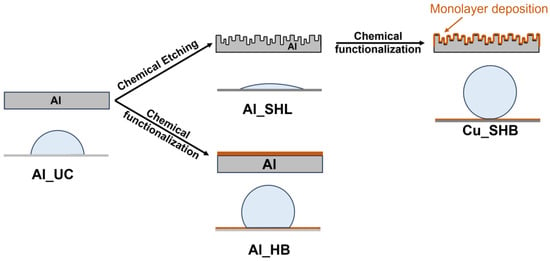
Figure 1.
Schematic representation of aluminum surface modification illustrating the transition from intrinsic wettability to a non-wetting state.
2.1. Substrate Preparation and Cleaning
Aluminum substrates of varying dimensions were prepared via sequential ultrasonic cleaning. All samples were first sonicated for 10 min in acetone to dissolve organic residues, then rinsed and sonicated in ethanol to remove remaining contaminants. Finally, specimens were flushed with deionized water and dried under a gentle nitrogen stream before further processing.
2.2. Chemical Etching for Surface Nanostructuring
To generate hierarchical micro- and nanostructures, cleaned aluminum substrates were immersed in a 3 M HCl solution at ambient temperature for 10 min. The acid selectively etches grain boundaries and defect sites, producing multi-scale surface roughness. Immediately after etching, the samples were thoroughly rinsed with deionized water, gently patted dry with lint-free tissue, and then dried under a gentle nitrogen stream to remove residual moisture from the hierarchical surface features and to arrest further oxidation.
2.3. Chemical Functionalization
To impart surface hydrophobicity, atmospheric pressure chemical vapor deposition with 1H,1H,2H,2H-perfluorooctyltriethoxysilane (PFOTES) purchased from sigma-aldrich (Bellefonte, PA, USA) was carried out. A PFOTES-ethanol solution was prepared in a 1:9 volume ratio (10% v/v). In this step, 1 mL of the PFOTES-ethanol mixture was placed into a glass beaker situated within a crystallizing dish alongside the aluminum specimens. A second beaker containing 5 mL DI water was added to provide humidity for surface hydrolysis. The sealed container was placed inside a hot air oven set at 150 °C for 4 h, facilitating the evaporation of the silane and the formation of a uniform monolayer coating on the aluminum substrate, as illustrated in Figure 2. Four surface conditions were prepared: Al_UC (uncoated aluminum), Al_HB (chemical functionalization only), Al_SHL (chemical etching only), and Al_SHB (combined chemical etching and functionalization).
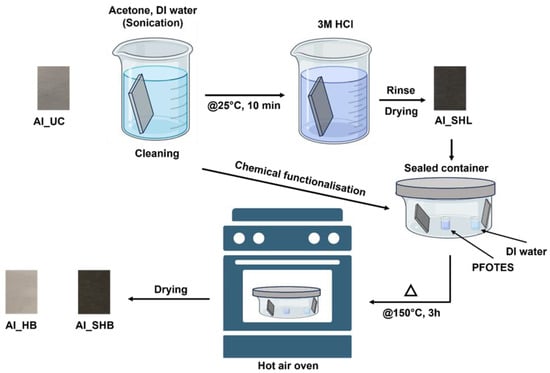
Figure 2.
Schematic illustration outlining the experimental approach adopted for the fabrication of diverse surface structures.
2.4. Surface Characterization
Surface morphology was analyzed using field-emission scanning electron microscopy (FE-SEM, SUPRA40VP, Zeiss, Oberkochen, Germany) operated in secondary electron mode to reveal detailed micro- and nanoscale structural characteristics. Topography and roughness measurements were obtained with a 3D laser confocal microscope (SURFVIEW-STANDARD, GLTech, Daejeon, Republic of Korea), providing quantitative data on surface variations.
The wettability of the aluminum substrates was evaluated with a Phoenix-Pico/Nano (SEO) contact angle goniometer (Surface Electro Optics Co., Ltd., Hwaseong, Republic of Korea) utilizing distilled water as the testing liquid. For each specimen (20 mm × 20 mm), measurements were carried out at three distinct positions to verify repeatability, and the mean value from these points was reported. Both advancing and receding contact angles were determined to analyze surface wetting characteristics and contact angle hysteresis. During each trial, a 5 µL water droplet dispensed and withdrawn at a rate of 1 µL/s, with droplet behavior monitored in real time using a high-resolution CCD camera. The roll-off angle was measured by gradually tilting the sample until the droplet began to roll off. The resulting images were processed with Surfaceware 9 software for assessing droplet mobility and the dynamics of the contact line on the aluminum surfaces. To evaluate the durability of the Cassie wetting state, contact angles were monitored over a 5-day period under ambient laboratory conditions.
Phase composition was investigated through X-ray diffraction (XRD, Rigaku RINT-2000, Rigaku, Tokyo, Japan) with a monochromatic Cu–Kα source (λ = 1.5406 Å). Scans were collected in the 2θ interval from 10° to 80°, with a step increment of 0.02° and a scanning rate of 2°/min, facilitating the identification of crystalline phases in both uncoated and surface-modified aluminum samples.
2.5. Electrochemical Measurements
Electrochemical corrosion studies were conducted using a Gamry Interface 1010E potentiostat configured in a standard three-electrode arrangement at ambient temperature. The aluminum specimen, with an exposed area of 1 cm2, was utilized as the working electrode, while a graphite rod served as the counter electrode and a saturated calomel electrode (SCE) was employed as the reference. Electrochemical measurements were carried out in 3.5 wt% NaCl aqueous solution.
Open circuit potential (OCP) for each sample was tracked continuously for a duration of 4 h to achieve equilibrium. Electrochemical impedance spectroscopy (EIS) was performed at the stabilized OCP, employing a 10 mV rms sinusoidal signal across a frequency window spanning from 105 Hz to 10−2 Hz. Potentiodynamic polarization scans were subsequently obtained by varying the applied potential from −0.3 V to +0.5 V relative to the OCP, maintaining a scan rate of 0.5 mV/s throughout the measurement. Corrosion potential () and corrosion current density () parameters were extracted from Tafel regions of the polarization data. Processing and fitting of EIS datasets were analyzed using Gamry Echem Analysis software (version 7.10.0). To validate consistency, every measurement was conducted at least three times, and only representative results have been presented.
Electrochemical impedance spectroscopy (EIS) results were interpreted using an equivalent electrical circuit containing solution resistance (), coating resistance (), charge transfer resistance (), constant phase elements corresponding to the coating () and the double layer (), along with Warburg impedance (), as shown in Figure 3 []. Constant phase elements were incorporated in the model to represent deviations from ideal capacitor behaviors, commonly attributed to surface non-uniformities at the electrode/electrolyte boundary. The mathematical expression for the impedance of a constant phase element (ZCPE) used was:

Figure 3.
Equivalent circuit diagrams used for electrochemical analysis of uncoated aluminum (left) and coated aluminum (right) surfaces.
Here, defines the magnitude of the CPE, is the angular frequency (rad/s), j is the imaginary unit (where j2 = −1), and (ranging between 0 and 1) indicates the extent of non-ideal capacitive behavior. Corrosion inhibition efficiency () was determined based on the measured charge transfer resistance values, following the relation:
where and is the charge transfer resistance values for coated and uncoated specimens, respectively, representing the barrier effect of surface modification in inhibiting corrosion. The corrosion rate, expressed in mils per year (MPY), was determined based on the measured corrosion current density (), utilizing the following equation:
where is reported in μA/cm2, denotes the equivalent weight of aluminum, and indicates the density of the metal [,]. Furthermore, the inhibition efficiency () was quantified from corrosion current density measurements using:
with icorr and icorr′ representing the current densities for the uncoated and coated specimens, respectively.
2.6. Salt Spray Test
To assess the corrosion performance of the modified aluminum substrates, salt spray experiments were carried out using an STP-90C-3 chamber (Suga, Daegu, Republic of Korea), strictly following the ASTM B117 protocol []. Before testing, each aluminum sample (4 cm × 6 cm) was degreased in acetone, rinsed with ultrapure water, and then air-dried to eliminate any contaminants. Within the salt fog cabinet, the solution of 5 wt% NaCl was atomized at a rate of 1.5 ± 0.5 mL h−1 under an air pressure of 0.9–1.1 bar, while the internal temperature was held at 35 ± 1 °C. Samples remained in this environment for a total of 1440 h. At predetermined time points, specimens were extracted, gently rinsed with DI water, and dried. Surface changes were documented visually, noting the appearance of rust, pitting, or other signs of degradation. Mass loss was quantified by recording each sample’s weight before exposure (Wi) and again after drying post-interval (Wf), allowing calculation of the corrosion rate over time. Corrosion rate (CR) measurements based on mass loss were determined by applying the following equation:
where and correspond to masses for the initial and final sample (in mg), represents the density of aluminum (g/cm3), is the total exposed area (cm2), and is the duration of exposure (hours). Each experiment was carried out in triplicate to confirm reproducibility, with only representative data presented.
3. Results and Discussion
3.1. Surface Characterization
Surface morphological evolution of the aluminum substrates was systematically examined by SEM following each modification step as shown in Figure 4. The pristine aluminum (Al_UC) displayed a smooth surface lined with parallel polishing grooves, indicative of minimal intrinsic roughness and absence of microscale or nanoscale features. Post-etching (Al_SHL), the surface transformed, revealing a hierarchical, cauliflower-like landscape composed of densely packed, nodular micro- and nanostructures that coalesce into a highly irregular topography, substantially amplifying the interfacial surface area. Subsequent PFOTES functionalization (Al_HB) resulted in a uniformly coated film; the underlying polishing marks were faintly visible, signifying the deposition of a conformal silane layer that preserves substrate flatness without introducing secondary roughness []. High-magnification insets verified that nanostructured protrusions remained well preserved beneath the hydrophobic coating, demonstrating successful integration of topographical and chemical modifications.
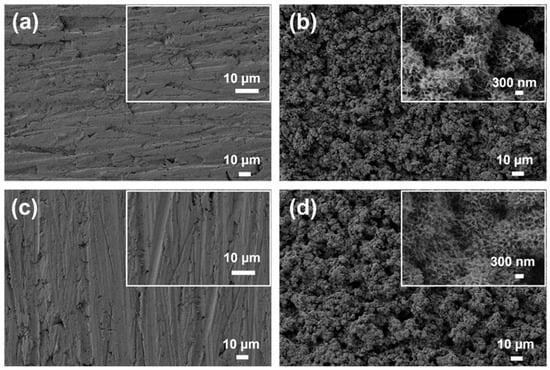
Figure 4.
SEM micrographs of aluminum substrates for various modified surfaces: (a) Al_UC, (b) Al_SHL, (c) Al_HB, and (d) Al_SHB. Insets provide enlarged views highlighting nanoscale morphology.
The dual-modified surface (Al_SHB) retained the hierarchical roughness from etching, now cloaked in a uniform, low-surface-energy silane layer as shown in Figure 5. The RMS roughness, which captures the standard deviation of the surface profile are Al_UC, 0.47 µm; Al_HB, 0.51 µm; Al_SHL, 2.64 µm; and Al_SHB, 2.72 µm. The elevated RMS values for Al_SHL and Al_SHB highlight the hierarchical architectural complexity essential for sustaining stable Cassie-Baxter wetting and enhanced barrier performance. The wetting behavior exhibited by each aluminum surface reflects the interplay of micro/nanotopography and surface chemistry introduced at each modification stage. The uncoated sample (Al_UC) demonstrated classic moderate wettability, with an advancing angle of 75° (hysteresis ≈ 20°), governed by a Young-type wetting regime where polishing grooves and oxide features act as pinning sites inhibiting droplet mobility []. After chemical etching (Al_SHL), the surface transitioned to a superhydrophilic state, with an advancing angle of 8° (hysteresis ≈ 4°), as hierarchical roughness amplified oxide hydrophilicity in alignment with the Wenzel model [], resulting in complete wetting and rapid water spreading as shown in Figure 6.
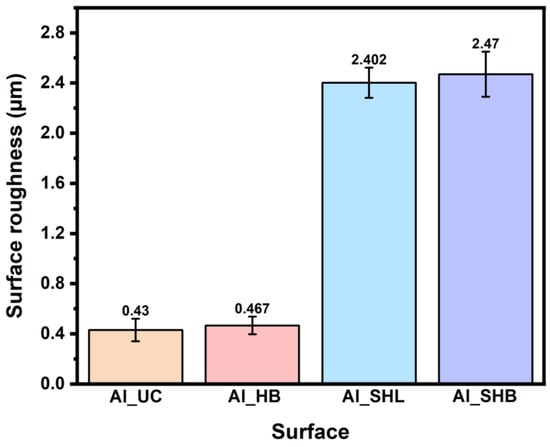
Figure 5.
Comparative analysis of surface roughness (Ra) values across all investigated samples.
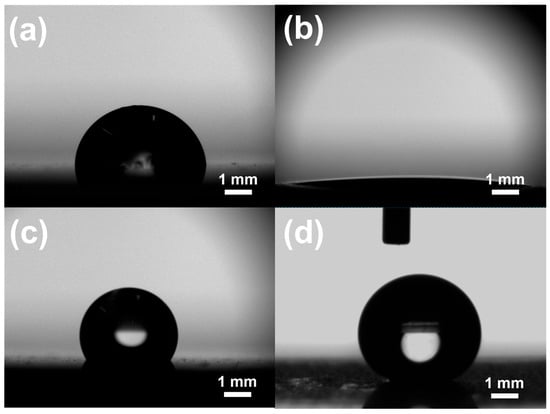
Figure 6.
Static measurement of water contact angle images for (a) Al_UC, (b) Al_SHL, (c) Al_HB, and (d) Al_SHB.
Upon PFOTES functionalization (Al_HB), the aluminum surface displayed hydrophobic behavior, with an advancing contact angle of 125° (hysteresis ≈ 7°). The low-surface-energy silane layer substantially increased water repellency, though some contact line pinning persisted due to residual topography. Interestingly, the dual-modified sample (Al_SHB) exhibited superhydrophobicity, with an advancing angle of 175° (hysteresis ≈ 5°) as shown in Figure 7. This Cassie–Baxter regime results from the combined effects of hierarchical structuring and PFOTES chemistry, leading to air entrapment within the roughness, minimal solid–liquid contact, and droplet mobility.
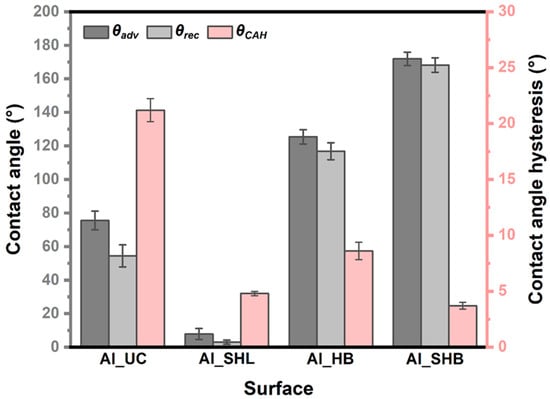
Figure 7.
Measurements of advancing, receding contact angles and hysteresis for all modified aluminum samples.
Low-contact-angle hysteresis on the superhydrophobic Al_SHB surfaces reflects minimal pinning of the contact line and allows water droplets to roll off effortlessly. The progression in wetting behavior—from moderate pinning on Al_UC (pristine smooth surface), to complete wetting on Al_SHL, to partial hydrophobicity on Al_HB, and finally to extreme water repellency with low hysteresis on Al_SHB demonstrates that hierarchical micro-nanostructure roughness alone or low-surface-energy silane coating alone cannot sustain the Cassie–Baxter state. The combination of both structured topography and chemical functionalization enables air entrapment, minimizes solid–liquid contact, and prevents liquid penetration, ensuring sustained superhydrophobic behavior and reliable droplet mobility.
Roll-off angles measurements were taken using the tilting plate method: a 5 μL water droplet was dispensed on each coated surface, and the substrate was gradually tilted until the minimum angle required for the droplet to roll off (the roll-off or sliding angle) was recorded. The superhydrophobic Al_SHB coatings consistently exhibited very low roll-off angles, in the range of 2–5°, indicative of minimal adhesion and effective Cassie-Baxter state stabilization. To evaluate the long-term stability (aging resistance) of the superhydrophobic state, static contact angle measurements were repeated every 24 h over a 5-day period under ambient conditions. As shown in Figure 8a, the contact angle remained above 155° throughout, demonstrating durable surface performance against environmental aging and persistent moisture exposure. Further, a dynamic water droplet impact test was conducted by subjecting the coated surface to continuous water droplets (1 drop per second). The contact angle and sliding angle were periodically measured during the impact cycles, and the results are presented in Figure 8b. Remarkably, after 200,000 successive water drops, the coating showed negligible degradation in wettability—maintaining high contact angles and low sliding angles—demonstrating excellent mechanical robustness and resistance to physical wear.
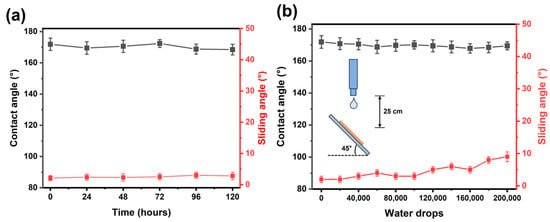
Figure 8.
Durability and stability measurements of superhydrophobic sample (Al_SHB) (a) aging for 5 days and (b) water drop test.
Figure 9 displays the X-ray diffraction (XRD) patterns obtained from both the uncoated and surface-modified aluminum specimens. The uncoated aluminum (Al_UC) reveals pronounced Bragg reflections at 2θ values of approximately 38.5°, 44.8°, 65.1°, and 78.2°, attributed to the (111), (200), (220), and (311) crystallographic planes of face-centered cubic aluminum, respectively, confirming the presence of pure Al phase. In all coated specimens—Al_SHL, Al_HB, and Al_SHB—the XRD profiles retain the major aluminum reflections, with no additional peaks or secondary phases detected, indicating that the chemical etching and PFOTES functionalization do not disrupt the underlying Al lattice or induce crystallographic transformations. The relative peak intensities show subtle variations, which may arise from surface morphology changes or thin film coverage, but all modified samples maintain the crystalline integrity of the substrate. The absence of new diffraction peaks and the consistency of phase composition across treatments demonstrate both the conformal nature of the coatings and the preservation of bulk aluminum’s structural characteristics. The clear distinction between peak intensity and shape illustrates the efficacy of the surface modification process in engineering the interface while maintaining the substrate’s crystallinity.
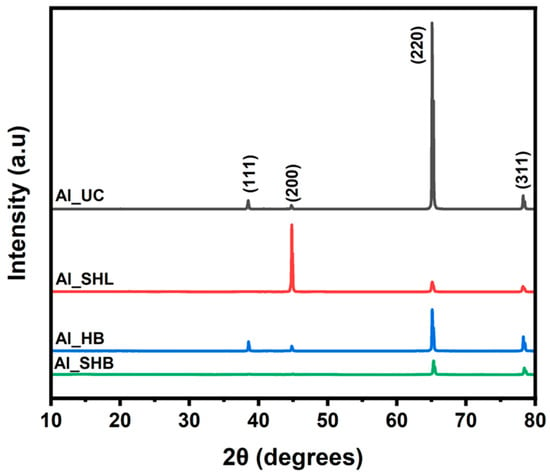
Figure 9.
X-ray diffraction (XRD) patterns of different aluminum samples with identification of corresponding crystallographic phases.
3.2. Electrochemical Measurements
To assess the corrosion inhibition properties of the modified aluminum samples, electrochemical impedance spectroscopy (EIS) was carried out on both uncoated and coated specimens in a 3.5 wt% NaCl aqueous solution. The fitted electrochemical parameters are summarized in Table 1.

Table 1.
Summary of electrochemical impedance spectroscopy (EIS) data and polarization characteristics measured for each aluminum sample.
The capacitive loop observed in the Nyquist plot does not form a perfect semicircle, which is commonly attributed to a dispersion effect. In the presence of such dispersion, the electrical double layer deviates from ideal capacitor behavior. Therefore, constant phase elements (CPEs) are often introduced into the equivalent circuit as substitutes for ideal capacitors in order to more accurately model the impedance behavior of the double layer [].
Figure 10 presents the Nyquist plots for each sample. Table 1 presents the impedance parameters obtained from the EIS measurements. The coated Al specimens exhibited relatively larger semicircles compared to the uncoated (UC) sample, with the SHB sample showing the highest Rp value. This indicates the superior hydrophobicity and corrosion resistance of the SHB coating. Upon coating, the inhibition efficiency increased significantly, with the SHB-coated sample exhibiting an IE% of 99.2%, indicating excellent corrosion protection performance. Figure 11 shows the Bode plots of the impedance modulus (|Z|). In the low-frequency region (typically below 10−1 Hz), the impedance modulus reflects the polarization resistance and is directly associated with corrosion resistance. The SHB sample exhibited the highest impedance value in the low-frequency range.
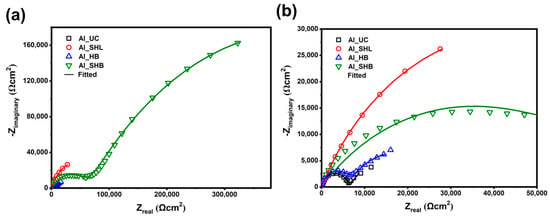
Figure 10.
(a) Nyquist diagrams obtained from EIS measurements illustrating sample impedance characteristics; (b) magnified views of Nyquist curves emphasizing regions with low impedance.
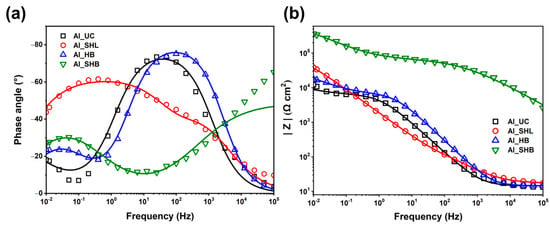
Figure 11.
(a) Bode plots displaying phase angle variation with frequency; (b) Bode plots presenting impedance modulus comparisons across measured samples.
Across the entire frequency spectrum, the SHB-coated sample maintained relatively high impedance values, indicating enhanced barrier properties against corrosive species and suppressed corrosion activity. These results are consistent with the Nyquist plots and the fitted equivalent circuit parameters, further confirming the effective corrosion protection provided by the SHB coating. Potentiodynamic polarization measurements were conducted, and the resulting curves are shown in Figure 12. The Ecorr and corrosion current density icorr values are summarized in Table 2. Ecorr, which represents the corrosion tendency of a material, shifted to more negative values upon coating []. The negative shift in corrosion potential upon coating reflects suppressed electrochemical activity due to the enhanced barrier properties of the hierarchical micro-nanostructured surface combined with the low-surface-energy PFOTES layer, which restricts ion transport and minimizes electrolyte-substrate contact []. Since the corrosion rate is directly proportional to the corrosion current density, it exhibits a corresponding trend [,].
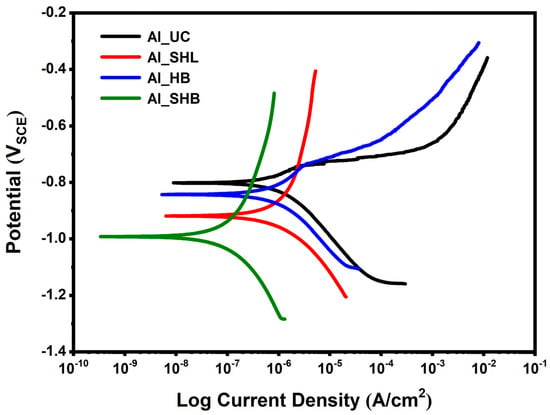
Figure 12.
Potentiodynamic polarization graphs illustrating variation in corrosion potentials and current densities among investigated samples.

Table 2.
Summary of potentiodynamic polarization parameters and the corrosion rates for the aluminum samples.
The enhanced corrosion protection observed for the superhydrophobic dual-modified Al_SHB coatings arises from well-established mechanisms characteristic of hydrophobic and superhydrophobic surfaces, as detailed in prior studies []. The hierarchical micro/nano roughness with low-surface-energy PFOTES functionalization establishes a Cassie–Baxter regime, wherein air pockets are entrapped beneath water droplets, significantly limiting the actual solid–liquid contact area. This composite interface prevents electrolyte infiltration and reduces the active corrosion sites on the aluminum substrate. Furthermore, the superhydrophobic layer acts as a physical barrier that impedes ion transport and restricts the acid-base interfacial reactions essential for corrosion initiation. In addition, the hierarchical roughness promotes a stable and protective film of oxide at the nanoscale that further hinders corrosion progression. Thus, the combined topographical and chemical modifications inhibit the mass transport of corrosive species. After coating, the corrosion rate decreased for all samples, with the SHB-coated sample showing the lowest value of 0.017 mpy, indicating superior corrosion resistance.
3.3. Corrosion Morphology over Time
Unmodified aluminum (Al_UC) displayed early pitting by 168 h, with small white corrosion products forming at discrete spots. These pits expanded and merged into a continuous, chalky oxide layer by 720 h, ultimately covering nearly the entire surface by 1440 h, indicative of aggressive chloride attack. In contrast, chemically etched samples (Al_SHL) remained largely unchanged until 360 h, exhibiting only faint whitish speckles at pit nucleation sites. Even after 1440 h, Al_SHL showed only sparse, shallow corrosion patches, demonstrating that the acid-etched micro-nano-roughness promotes formation of a cohesive, self-limiting alumina barrier that arrests pit propagation. Silane-functionalized surfaces (Al_HB) developed isolated white spots at 168 h; these spots gradually increased in number but remained confined through 720 h, reflecting the PFOTES layer’s ability to limit electrolyte film formation and retard pit initiation. By 1440 h, Al_HB exhibited moderate spread of discrete corrosion islands, yet large areas of the substrate remained intact. The dual-treated specimens (Al_SHB) offered the most effective protection: minor, transient white residues appeared only at 168 h and receded by 360 h, and only submillimeter pits emerged by 1440 h, confined to isolated locations as shown in Figure 13. This dual-modified surface thus demonstrated a pronounced delay in both initiation and propagation of corrosion compared to single-treatment and uncoated specimens.
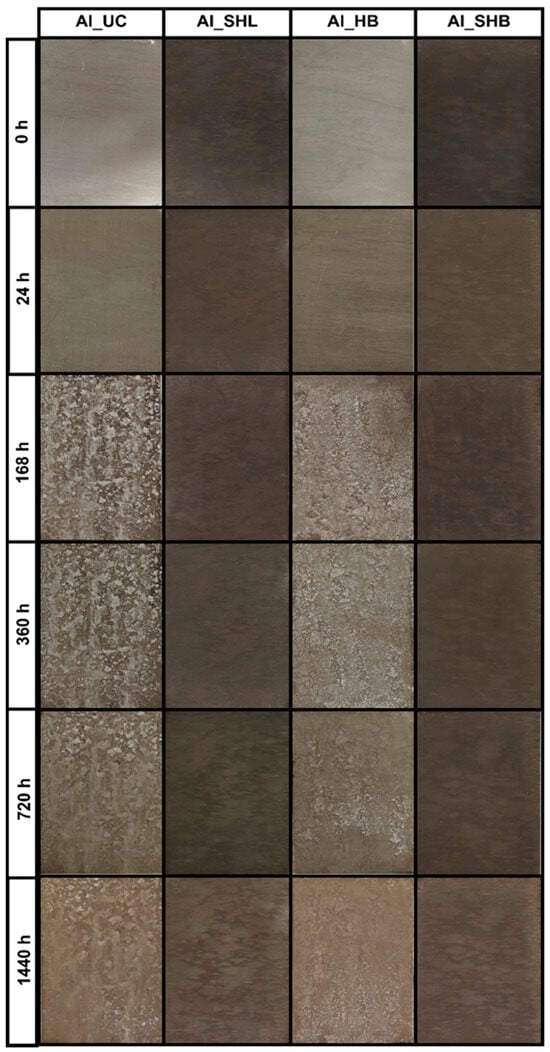
Figure 13.
Photographs depicting the results of the test with salt spray for different aluminum surfaces following 1440 h of exposure in a 5 wt% NaCl environment.
3.4. Quantitative Mass Change and Corrosion Rates
Gravimetric data mirror the visual trends as shown in Figure 14. After 24 h, Al_UC gained 58 mg, whereas Al_SHB increased by 0 mg. After 1440 h, Al_UC exhibited a 925 mg gain, corresponding to 2.51 mm/year, while Al_SHL, Al_HB, and Al_SHB showed mass increases of 124 mg (0.81 mm/year), 598 mg (1.12 mm/year), and 35 mg (0.36 mm/year), respectively. The results demonstrate that the combined etching and silane treatment (Al_SHB) effectively decreases the corrosion rate by more than ten times compared to the untreated substrate. The robust corrosion resistance demonstrated under prolonged salt spray exposure, coupled with retained superhydrophobic properties, underscores the potential of this method for diverse applications in marine, aerospace, and infrastructure sectors requiring long-term environmental protection.
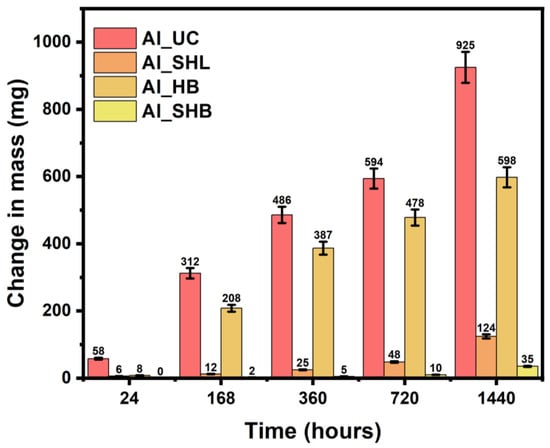
Figure 14.
Changes in sample mass over the duration of exposure to salt spray testing.
4. Conclusions
The dual-step surface engineering approach presented herein, which combines controlled HCl etching with PFOTES vapor-phase functionalization to establish hierarchical micro-nanostructures and tailored surface chemistry, demonstrates significant advancement over conventional acid etching and fluorinated silane strategies documented in the existing literature. The resultant superhydrophobic surfaces exhibited outstanding water repellency with static contact angles reaching up to 175° and extremely low-contact-angle hysteresis of approximately 5°, enabling reliable droplet mobility. Electrochemical testing and salt spray exposure confirmed a dramatic improvement in corrosion resistance, reducing both corrosion rates and surface degradation in aggressive chloride environments. Unlike many conventional techniques, this approach is simple, scalable, and maintains structural and functional integrity under prolonged testing, making it highly suitable for practical deployment in demanding applications where durability, self-cleaning, and advanced corrosion protection are critical.
Author Contributions
Conceptualization, N.R. and M.-S.O.; Methodology, N.R., H.-E.S. and M.-S.O.; Validation N.R., H.-E.S. and M.-S.O.; Formal analysis, N.R. and H.-E.S.; Investigation N.R., H.-E.S. and M.-S.O.; Data curation N.R. and H.-E.S.; Writing—original draft N.R. and H.-E.S.; Writing—review and editing N.R., H.-E.S., S.W.L. and M.-S.O.; Project administration M.-S.O. and S.W.L. All authors have read and agreed to the published version of the manuscript.
Funding
This research was supported by the National Research Foundation of Korea (NRF) grant funded by the Korea Government (Ministry of Science and ICT), grant number RS-2025-24533296. Part of this research was also supported by Glocal University 30 project at Jeonbuk National University in 2025.
Data Availability Statement
The original contributions presented in this study are included in the article. Further inquiries can be directed to the corresponding author.
Conflicts of Interest
Author Sang Won Lee was employed by the company Korea Carbon Industry Promotion Agency. The remaining authors declare that the research was conducted in the absence of any commercial or financial relationships that could be construed as a potential conflict of interest.
References
- Xiang, L.; Tao, J.; Xia, X.; Zhao, Z.; Chen, Q.; Su, Y.; Chai, S.; Zheng, Z.; Sun, J. Impact of marine atmospheric corrosion on the microstructure and tensile properties of 7075 high-strength aluminum alloy. Materials 2023, 16, 2396. [Google Scholar] [CrossRef]
- Huang, G.Q. Corrosion behavior of aluminum alloys in seawater. Corros. Sci. Technol. 2002, 31, 215. [Google Scholar]
- Knudsen, O.Ø.; Bertram, J. Corrosion of Aluminium in Marine Environments. 2023. Available online: https://www.sintef.no/contentassets/adf31392734e496c805e9cbfad888c2f/report---corrosion-of-al-in-marine-environments.pdf (accessed on 20 August 2025).
- Olkowicz, K.; Buczko, Z.; Nasiłowska, B.; Kowalczyk, K.; Czwartos, J. Superhydrophobic coating based on porous aluminum oxide modified by polydimethylsiloxane (PDMS). Materials 2022, 15, 1042. [Google Scholar] [CrossRef] [PubMed]
- Rahul, N.; Kumar, N.; Sett, S. Delayed Condensation on Nanoparticle Coated Transparent Lubricant-Infused Surfaces. In Proceedings of the 27th National and 5th International ISHMT-ASTFE Heat and Mass Transfer Conference, 2023, IIT Patna, Patna-801106, Bihar, India, 14–17 December 2024; Begel House Inc.: Danbury, CT, USA, 2024. [Google Scholar]
- Zheng, S.; Li, C.; Fu, Q.; Xiang, T.; Hu, W.; Wang, J.; Ding, S.; Liu, P.; Chen, Z. Fabrication of a micro-nanostructured superhydrophobic aluminum surface with excellent corrosion resistance and anti-icing performance. Rsc Adv. 2016, 6, 79389–79400. [Google Scholar] [CrossRef]
- Orejon, D.; Oh, J.; Preston, D.J.; Yan, X.; Sett, S.; Takata, Y.; Miljkovic, N.; Sefiane, K. Ambient-mediated wetting on smooth surfaces. Adv. Colloid Interface Sci. 2024, 324, 103075. [Google Scholar] [CrossRef] [PubMed]
- Rahul, N.; Park, B.; Pradhan, S.K.; Sung, H.E.; Jeong, I.H.; Yun, Y.S.; Oh, M.S. Scalable Engineering of Superhydrophobic Copper Surfaces with Enhanced Corrosion Resistance by Combined Nanostructuring and Chemical Vapor Deposition. Materials 2025, 18, 3981. [Google Scholar] [CrossRef]
- Thomas, T.M.; Mahapatra, P.S. Fabrication of hierarchically textured aluminum-based superhydrophobic surfaces for anti-frosting application. Mater. Today Proc. 2022, 56, 1267–1273. [Google Scholar] [CrossRef]
- Eom, H.; Lee, J.; Kim, J.; Hong, M.; Kim, K.; Jang, H.; Lee, D.; Lim, H.; Jiong, S.; Choi, W. Scalable and tunable micro/nanostructuring of aluminum surfaces via chemical etching for enhanced heat dissipation. Appl. Therm. Eng. 2025, 274, 126729. [Google Scholar] [CrossRef]
- Fang, C.; Pu, M.; Zhou, X.; Lei, W.; Pei, L.; Wang, C. Facile preparation of hydrophobic aluminum oxide film via sol-gel method. Front. Chem. 2018, 6, 308. [Google Scholar] [CrossRef]
- da Silva, R.G.; Malta, M.I.; da Silva, J.J.; da Silva Filho, W.L.; Cirino, J.A.; de Oliveira, S.H.; Vinhas, G.M.; Vieira, M.R. Study of a fluorine-free silane-based film on an aluminum alloy via drop-coating method with the purpose of providing hydrophobic and corrosion protection properties. Mater. Chem. Phys. 2025, 329, 130099. [Google Scholar] [CrossRef]
- Barthwal, S.; Barthwal, S. Engineering a robust, multifunctional superhydrophobic/oleophobic microporous aluminum surface via a two-step chemical etching process. Surf. Interfaces 2024, 46, 103933. [Google Scholar] [CrossRef]
- Adarraga, O.; Agustín-Sáenz, C.; Bustero, I.; Brusciotti, F. Superhydrophobic and oleophobic microtextured aluminum surface with long durability under corrosive environment. Sci. Rep. 2023, 13, 1737. [Google Scholar] [CrossRef] [PubMed]
- Roy, A.; Dutta, M.; Nallana, R.; Sett, S. Sustainable Non-PFAS Hydrophobic Surfaces from Naturally Derived Sepiolite, Myristic Acid, and Ethyl Cellulose for Stable Dropwise Condensation. Small 2025, e05314. [Google Scholar] [CrossRef]
- Khaskhoussi, A.; Calabrese, L.; Proverbio, E. Anticorrosion superhydrophobic surfaces on AA6082 aluminum alloy by HF/HCl texturing and self-assembling of silane monolayer. Materials 2022, 15, 8549. [Google Scholar] [CrossRef]
- Cui, C.; Cao, Y.; Qi, B.; Wei, J.; Yuan, J.; Wang, Y. Convenient and large-scale fabrication of cost-effective superhydrophobic aluminum alloy surface with excellent reparability. Langmuir 2021, 37, 7810–7820. [Google Scholar] [CrossRef]
- Maghsoudi, K.; Momen, G.; Jafari, R. The thermodynamic stability of the Cassie–Baxter regime determined by the geometric parameters of hierarchical superhydrophobic surfaces. Appl. Mater. Today 2023, 34, 101893. [Google Scholar] [CrossRef]
- Wang, X.; Fu, C.; Zhang, C.; Qiu, Z.; Wang, B. A comprehensive review of wetting transition mechanism on the surfaces of microstructures from theory and testing methods. Materials 2022, 15, 4747. [Google Scholar] [CrossRef] [PubMed]
- Bhushan, B.; Nosonovsky, M.; Chae Jung, Y. Towards optimization of patterned superhydrophobic surfaces. J. R. Soc. Interface 2007, 4, 643–648. [Google Scholar] [CrossRef] [PubMed]
- Liu, T.; Yin, Y.; Chen, S.; Chang, X.; Cheng, S. Super-hydrophobic surfaces improve corrosion resistance of copper in seawater. Electrochim. Acta 2007, 52, 3709–3713. [Google Scholar] [CrossRef]
- Yunying, X.; Wenxin, H.; Yi, C.; Guangxin, W.; Jieyu, Z. Effect of heat treatment process on microstructure and corrosion resistance of Al–10% Si–24% Zn coating. Surf. Coat. Technol. 2020, 401, 126305. [Google Scholar] [CrossRef]
- Xu, X.; Yang, Z.; Ye, Y.; Wang, G.; He, X. Effects of various Mg/Si ratios on microstructure and performance property of Al-Mg-Si alloy cables. Mater. Charact. 2016, 119, 114–119. [Google Scholar] [CrossRef]
- ASTM B117-19; Standard Practice for Operating Salt Spray (Fog) Apparatus. ASTM International: West Conshohocken, PA, USA, 2019.
- Devra, R.S.; Gupta, R.; Rahul, N.; Sett, S.; Vadali, M. Transitioning Surface Wettability of Ti6Al4V via Laser Ablation and Post-processing Methods. J. Bio-Tribo-Corros. 2025, 11, 39. [Google Scholar] [CrossRef]
- Rahul, N.; Kalita, S.; Sen, P.; Shil, B.; Sen, D. Enhanced pool boiling heat transfer characteristics on microstructured copper surfaces coated with hybrid nanofluid. J. Therm. Anal. Calorim. 2024, 149, 6281–6293. [Google Scholar] [CrossRef]
- Lee, H.S.; Singh, J.K.; Ismail, M.A.; Bhattacharya, C.; Seikh, A.H.; Alharthi, N.; Hussain, R.R. Corrosion mechanism and kinetics of Al-Zn coating deposited by arc thermal spraying process in saline solution at prolong exposure periods. Sci. Rep. 2019, 9, 3399. [Google Scholar] [CrossRef] [PubMed]
- Sacilotto, D.G.; Kunst, S.R.; Soares, L.G.; Carone, C.L.P.; Arnold, D.C.M.; Oliveira, C.T.; Ferreira, J.Z. Corrosion resistance of 5052 aluminum alloy using hydrophobic silane coatings. Matéria 2025, 30, e20240919. [Google Scholar]
- Boinovich, L.B.; Emelyanenko, A.M.; Modestov, A.D.; Domantovsky, A.G.; Emelyanenko, K.A. Not simply repel water: The diversified nature of corrosion protection by superhydrophobic coatings. Mendeleev Commun. 2017, 27, 254–256. [Google Scholar] [CrossRef]
Disclaimer/Publisher’s Note: The statements, opinions and data contained in all publications are solely those of the individual author(s) and contributor(s) and not of MDPI and/or the editor(s). MDPI and/or the editor(s) disclaim responsibility for any injury to people or property resulting from any ideas, methods, instructions or products referred to in the content. |
© 2025 by the authors. Licensee MDPI, Basel, Switzerland. This article is an open access article distributed under the terms and conditions of the Creative Commons Attribution (CC BY) license (https://creativecommons.org/licenses/by/4.0/).